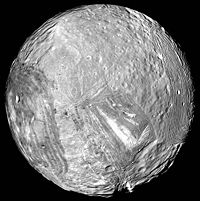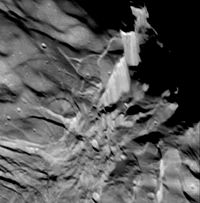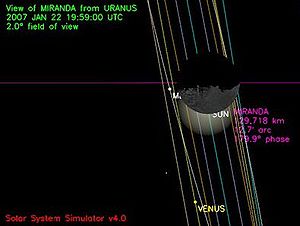- Miranda (moon)
-
For other uses, see Miranda (disambiguation).
Miranda  Discovery
DiscoveryDiscovered by Gerard P. Kuiper Discovery date February 16, 1948 DesignationsAlternate name(s) Uranus V Adjective Mirandan, Mirandian Semi-major axis 129 390 km Eccentricity 0.0013 Orbital period 1.413 479 d Inclination 4.232° (to Uranus' equator) Satellite of Uranus Physical characteristicsDimensions 480×468.4×465.8 km Mean radius 235.8 ± 0.7 km (0.03697 Earths)[1] Surface area 700 000 km2 Volume 54 835 000 km3 Mass 6.59 ± 0.75 × 1019 kg[2] (1.103 × 10–5 Earths) Mean density 1.20 ± 0.15 g/cm3[2] Equatorial surface gravity 0.079 m/s2 Escape velocity 0.193 km/s Rotation period synchronous Axial tilt 0° Albedo 0.32 Surface temp.
solstice[4]min mean max ? ~60 K 84 ± 1 K Apparent magnitude 15.8[3] Miranda (
 /mɨˈrændə/)[5] is the smallest and innermost of Uranus' five major moons.
/mɨˈrændə/)[5] is the smallest and innermost of Uranus' five major moons.It was discovered by Gerard Kuiper on February 16, 1948 at McDonald Observatory. It was named after Miranda from William Shakespeare's play The Tempest by Kuiper in his report of the discovery.[6] The adjectival form of the name is Mirandan. It is also designated Uranus V.
So far the only close-up images of Miranda are from the Voyager 2 probe, which made observations of the moon during its Uranus flyby in January, 1986. During the flyby the southern hemisphere of the moon was pointed towards the Sun so only that part was studied. Miranda shows more evidence of past geologic activity than any of the other Uranian satellites.
Contents
Physical characteristics
Miranda's surface may be mostly water ice, with the low density body also probably containing silicate rock and organic compounds in its interior.
Miranda's surface has patchwork regions of broken terrain indicating intense geological activity in the moon's past, and is criss-crossed by huge canyons. Large 'racetrack'-like grooved structures, called coronae, may have formed via extensional processes at the tops of diapirs, or upwellings of warm ice.[8][9] The ridges probably represent extensional tilt blocks. The canyons probably represent graben formed by extensional faulting. Other features may be due to cryovolcanic eruptions of icy magma. The diapirs may have changed the density distribution within the moon, which could have caused Miranda to reorient itself,[10] similar to a process believed to have occurred at Saturn's geologically active moon Enceladus. Miranda is one of the few bodies in the solar system in which the equatorial circumference is shorter than the pole-to-pole circumference, probably a consequence of the diapir activity.
Miranda's past geological activity is believed to have been driven by tidal heating at a time when its orbit was more eccentric than currently. Early in its history, Miranda was apparently captured into a 3:1 orbital resonance with Umbriel, from which it subsequently escaped.[11] The resonance would have increased orbital eccentricity; resulting tidal friction due to time-varying tidal forces from Uranus would have caused warming of the moon's interior. In the Uranus system, due to the planet's lesser degree of oblateness, and the larger relative size of its satellites, escape from a mean motion resonance is much easier than for satellites of Jupiter or Saturn. Miranda's orbital inclination (4.34°) is unusually high for a body so close to the planet. Miranda probably escaped from its resonance with Umbriel via a secondary resonance, and the mechanism of this escape is believed to explain why its orbital inclination is more than 10 times those of the other large Uranian moons (see Uranus' natural satellites).[12][13]
Miranda may have also once been in a 5:3 resonance with Ariel, which would have also contributed to its internal heating. However, the maximum heating attributable to the resonance with Umbriel was likely about three times greater.[11]
An earlier theory, proposed shortly after the Voyager 2 flyby, was that a previous incarnation of Miranda was shattered by a massive impact, with the fragments reassembling and denser ones subsequently sinking to produce the current strange pattern.[8]
Scientists recognize the following geological features on Miranda:
- Craters
- Coronae (large ovoid features)
- Regiones (geological regions)
- Rupes (scarps)
- Sulci (parallel grooves)
See also
References
- ^ Thomas, P. C. (1988). "Radii, shapes, and topography of the satellites of Uranus from limb coordinates". Icarus 73 (3): 427–441. Bibcode 1988Icar...73..427T. doi:10.1016/0019-1035(88)90054-1.
- ^ a b Jacobson, R. A.; Campbell, J.K.; Taylor, A.H. and Synnott, S.P. (1992). "The masses of Uranus and its major satellites from Voyager tracking data and Earth based Uranian satellite data". The Astronomical Journal 103 (6): 2068–78. Bibcode 1992AJ....103.2068J. doi:10.1086/116211.
- ^ "Planetary Satellite Physical Parameters". JPL (Solar System Dynamics). 2009-04-03. http://ssd.jpl.nasa.gov/?sat_phys_par. Retrieved 2009-08-10.
- ^ Hanel, R.; Conrath, B.; Flasar, F. M.; Kunde, V.; Maguire, W.; Pearl, J.; Pirraglia, J.; Samuelson, R. et al. (1986). "Infrared Observations of the Uranian System". Science 233 (4759): 70. Bibcode 1986Sci...233...70H. doi:10.1126/science.233.4759.70. PMID 17812891.
- ^ In US dictionary transcription, US dict: m
ı·răn′·də. - ^ Kuiper, G. P., The Fifth Satellite of Uranus, Publications of the Astronomical Society of the Pacific, Vol. 61, No. 360, p. 129, June 1949
- ^ "PIA00044: Miranda high resolution of large fault". JPL, NASA. http://photojournal.jpl.nasa.gov/catalog/PIA00044. Retrieved 2007-07-23.
- ^ a b c Chaikin, Andrew (2001-10-16). "Birth of Uranus' Provocative Moon Still Puzzles Scientists". Space.Com. Imaginova Corp.. http://www.space.com/scienceastronomy/solarsystem/miranda_creation_011016-1.html. Retrieved 2007-12-07.
- ^ Pappalardo, R. T.; Reynolds, S. J. & Greeley, R. (1997-06-25). "Extensional tilt blocks on Miranda: Evidence for an upwelling origin of Arden Corona". Journal of Geophysical Research (Elsevier Science) 102 (E6): 13,369–13,380. Bibcode 1997JGR...10213369P. doi:10.1029/97JE00802. http://www.agu.org/pubs/crossref/1997/97JE00802.shtml.
- ^ Pappalardo, R.; Greeley, R. (1993). "Structural evidence for reorientation of Miranda about a paleo-pole". In Lunar and Planetary Inst., Twenty-Fourth Lunar and Planetary Science Conference. Part 3: N-Z. pp. 1111–1112. http://adsabs.harvard.edu/abs/1993LPI....24.1111P. Retrieved 2006-08-05.
- ^ a b Tittemore, W. C.; Wisdom, J. (June 1990). "Tidal evolution of the Uranian satellites III. Evolution through the Miranda-Umbriel 3:1, Miranda-Ariel 5:3, and Ariel-Umbriel 2:1 mean-motion commensurabilities". Icarus (Elsevier Science) 85 (2): 394–443. Bibcode 1990Icar...85..394T. doi:10.1016/0019-1035(90)90125-S. http://www.sciencedirect.com/science?_ob=ArticleURL&_udi=B6WGF-473182X-22Y&_coverDate=06%2F30%2F1990&_alid=431841654&_rdoc=1&_fmt=&_orig=search&_qd=1&_cdi=6821&_sort=d&view=c&_acct=C000052082&_version=1&_urlVersion=0&_userid=1234512&md5=d7959dcca75860d54783b9dda43cacba.
- ^ Tittemore, W. C.; Wisdom, J. (1989). "Tidal Evolution of the Uranian Satellites II. An Explanation of the Anomalously High Orbital Inclination of Miranda". Icarus 78 (1): 63–89. Bibcode 1989Icar...78...63T. doi:10.1016/0019-1035(89)90070-5.
- ^ Malhotra, R., Dermott, S. F. (1990). "The Role of Secondary Resonances in the Orbital History of Miranda". Icarus 85 (2): 444–480. Bibcode 1990Icar...85..444M. doi:10.1016/0019-1035(90)90126-T.
External links
- Miranda Profile at NASA's Solar System Exploration site
- Miranda page at The
Nine8 Planets - Miranda, a Moon of Uranus at Views of the Solar System
- Paul Schenk's 3D images and flyover videos of Miranda and other outer solar system satellites
- Miranda Nomenclature from the USGS Planetary Nomenclature web site
Uranus Discovery 
Characteristics - Atmosphere
- Climate (Uranus Dark Spot)
- Magnetosphere
- Rings
- Moons
Major moons Exploration - Voyager program (Voyager 2)
- Uranus orbiter and probe (proposed)
Miscellaneous - 15 Orionis
- Uranus-crossing minor planets
- Uranus in fiction
Moons of Uranus Generally listed in increasing distance from UranusInner Major (spheroid) Outer (irregular) Geological features - Arielian
- (Kachina Chasma
- Yangoor)
- Mirandian
- (Verona Rupes)
- Oberonian
- (Hamlet
- Mommur Chasma)
- Puckian
- Titanian
- (Gertrude
- Messina Chasma
- Ursula
- Rousillon Rupes)
- Umbrielian
- (Wunda
- Vuver
- Skynd)
Natural satellites of the Solar System Planetary satellites 
Other satellite systems Largest satellites - Inner satellites
- Trojans
- Irregulars
- List
- Timeline of discovery
- Naming
Categories:- Moons of Uranus
- Astronomical objects discovered in 1948
Wikimedia Foundation. 2010.


